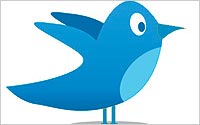 Twitter finally began rolling out what it calls "self-serve" ads earlier this month with a handful of brands that can now set up and run their own Promoted
Products campaigns. The technology to power the platform -- more than a year in the making -- has gone through several iterations, but now works similar to Google AdWords. Advertisers simply go online
and buy ads with a credit card.
Twitter finally began rolling out what it calls "self-serve" ads earlier this month with a handful of brands that can now set up and run their own Promoted
Products campaigns. The technology to power the platform -- more than a year in the making -- has gone through several iterations, but now works similar to Google AdWords. Advertisers simply go online
and buy ads with a credit card.
The self-serve product, aimed at growing Twitter's ad business, will better support small and medium-sized companies, helping to build an audience on the social
site. It will allow brands to reach out and better communicate with the people they want to reach. The plan is to roll out the platform to more advertisers in the coming weeks.
Twitter
supports 100 million users per month. Fifty million log in daily, with 250 million tweets daily; 2,400 advertisers with an 80% retention rate; and about half the use occurring through mobile devices.
eMarketer estimates that Twitter's global ad revenue will grow 210% to $139.5 million in 2011 -- up from just $45 million in 2010, the company's first full year of selling advertising.
advertisement
advertisement
Next
year, Twitter is projected to earn $260 million in worldwide ad revenue, up 86.3% over 2011. Providing some perspective on market growth, eMarketer estimates that self-serve advertising accounts for
about 60% of Facebook's global ad revenue, which will reach $3.8 billion in 2011.
Adam Bain, chief revenue officer at Twitter, explains Promoted Tweets, Promoted Trends, and Promoted Accounts. For marketers,
engagement represents a click on a link, but also a rebroadcast of a tweet or the ability to favorite a brand message. Self-service will allow Twitter to gain scale. Not the kind of self-serve
platform that MediaPost reported earlier this year, but a platform similar to Google
AdWords that enables small businesses to pay by credit card. (Okay -- a technicality.)
For Twitter, self-serve is part of a long-term strategy to build out its advertising services
through a scalable network. Today, the feature remains available only to existing advertisers. "The experience for them is the same as it has been," said Matt Graves, a Twitter spokesperson.
"They log into the Twitter advertiser dashboard to set up and manage campaigns. The only difference is that they now have the ability to add and store a credit card, which they can use to pay for
campaigns."
Advertisers use their stored credit cards to pay for Promoted Tweets and Promoted Products campaigns. Both products are based on a bid marketplace, Graves said. Advertisers place
bids for what they are willing to pay for an engagement with their ads. In the case of Promoted Tweets, this means paying each time someone clicks on, replies to, favorites or retweets their Promoted
Tweet. In the case of Promoted Accounts, it means paying each time someone follows their account.
There is no limit on the number of campaigns an advertiser can run. Targeting options are the
same as they have been in the past. Brands can target specific keywords by location, such as country and state, and also by specific groups of users, such as a brand's followers.
Graves
declined to comment on the minimum bid pricing or minimum campaign commitment.